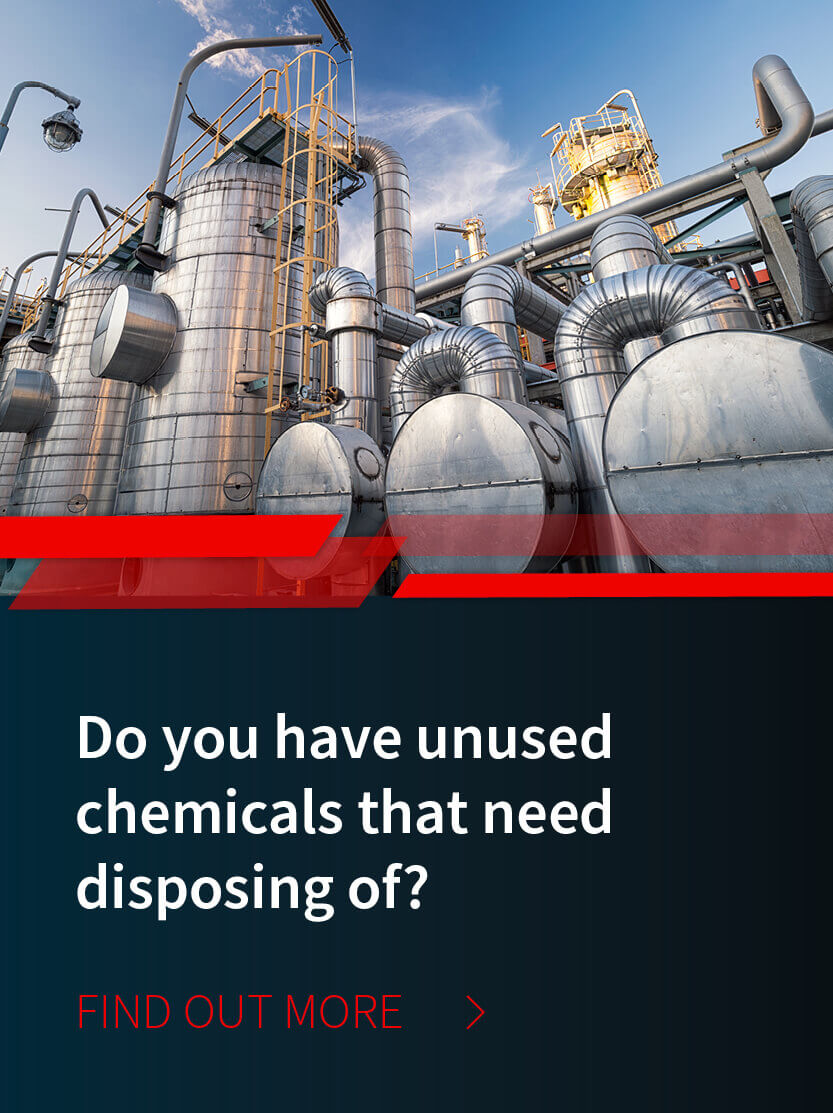
/ IN THIS BLOG
01 / Guidelines for Disposing of PFAS
Polyfluoroalkyl substances, better known as PFAS, are widely used chemicals with significant value in a wide range of consumer, commercial, and industrial applications. However, recent discoveries have revealed that these “forever chemicals” may pose significant health risks.
These discoveries and subsequent action from lawmakers have resulted in many requirements regarding the handling and disposal of PFAS. As a result, many industries must navigate the challenges of disposing of PFAS responsibly.
With quickly developing research as well as changing federal and state regulations regarding the disposal of PFA-containing waste, it is crucial to understand current best practices for their disposal. Here, we take a closer look at what PFAS are, why they are so dangerous, and how to dispose of them properly.
02 / What Are PFAS and Where Are They Used?
Chemically speaking, polyfluoroalkyl substances are a group of chemical compounds that contain multiple fluorine atoms attached to an alkyl chain. There are thousands of different PFAS, with many being far more studied and widely used than others. However, what they have in common is a strong fluorine carbon bond that gives them their useful chemical properties.
These properties include inherent stability and resistance to breakdown and can be a key benefit in many products. It is also why they are known as “forever chemicals.” PFAS have often been used to make products oil and stain-resistant, waterproof, and non-stick, among many other applications.
People have been using PFAS in industrial and consumer applications since the 1940s, so they are present in countless products, from clothing to food wrappers. However, only in recent decades have their dangers slowly become apparent.
03 / What Makes PFAS Dangerous?
Research concerning the exact threats posed by PFAS is still in its early stages. However, findings have uncovered many potential concerns. Studies have found associations between exposure to specific PFAS and a range of adverse health effects. According to the EPA, studies have shown that these can include:
Developmental issues, such as low birth weight, bone variations, accelerated puberty, and behavioral changes in children
Interference with immune and thyroid functions
Increased risks of kidney, prostate, and testicular cancers
Reproductive issues, including decreased fertility and high blood pressure in pregnant women
Increased cholesterol and obesity risks
The health dangers associated with PFAS are only made more serious by the fact that nearly everyone has already been exposed to them. Due to their widespread use for many decades, PFAS can be found in the soil, water, and air across most of the world.
In fact, due to their near-ubiquitous presence and resistance to breaking down, studies have found measurable amounts of PFAS are already present in the blood of nearly the entire population of most developed countries.
04 / How Can PFAS Be Properly Disposed Of?
It is safe to say that PFAS potentially present a significant risk to human health and can easily spread when released into the environment. However, due to their widespread use in a variety of industries, many organizations must continue to determine how they can best be disposed of.
Currently, the EPA and other organizations are continuing to determine the best methods for disposal. It’s important to know that this area of waste management is quickly evolving, particularly on a state level, where many regulations are often far more stringent than their federal counterparts. However, until further developments are made, the EPA has released interim guidance for safe methods of PFAS disposal.
These approved methods include:
Incineration
Hazardous waste landfills
Deep well injection
The exact method chosen may depend upon the type of PFA-containing substance being disposed of. However, it is crucial to ensure that these methods are used whenever PFA waste is disposed of.
05 / Incineration
Waste incineration technologies, including waste to energy, can potentially achieve the mixture of temperature and residence time necessary to break PFAS down and destroy pollutants. A wide range of hazardous wastes are treated using this method. Incineration has the potential to permanently eliminate PFAS, preventing their escape into the environment.
For this reason, incineration or thermal treatment is a promising disposal method that is compliant with existing disposal regulations with the potential to remove the threat of PFAS from the environment. However, due to the strong fluorine carbon bonds present in PFAS, there is a high risk of release into the environment when incineration is improperly managed. Due to this, it is crucial for those disposing of PFAS to work with an experienced hazardous waste disposal expert to ensure proper disposal.
06 / Hazardous Waste Landfill
Waste generators do have the option of disposing of PFA-containing materials in hazardous waste landfills. This waste cannot be disposed of in ordinary municipal landfills. Instead, it is disposed of in landfills that use extensive environmental controls and record keeping to prevent leaching and gas escape.
This disposal method is acceptable under current guidelines but does not eliminate the threat of PFAS. Instead, it will only contain them until they escape or degrade, or another method for treatment is used.
07 / Deep Well Injection
Deep well injection is the final disposal option available under the EPA’s interim guidance. This method for disposal “injects” PFA-containing wastes deep underground, well beneath the level where drinking water travels.
These wells must be located in a geologically stable area with impervious rock formations both above and below the injection site. These sites typically must be capable of trapping the waste for as long as it remains hazardous. Current regulations define this period as being up to 10,000 years.
08 / MCF Supports Compliant Waste Disposal
If your business handles or generates PFAS, you should stay ahead of any future EPA regulations and treat this waste stream responsibly. Since PFAS are best dealt with using specialized disposal methods, partnering with MCF Environmental Services to ensure the proper means of final elimination occur guarantees your business is doing its due diligence to protect the environment and observe best practices.
MCF can recommend a suitable and cost-efficient method of disposal appropriate for the PFAS created by your business. Whether a simple incineration disposal that guarantees PFAS will no longer pose a human and environmental hazard or a waste-to-energy method that can help recycle waste into energy for giving back to your business, MCF will take the headache of cautiously disposing of PFAS off of your mind.
Robert Losurdo
President, COO








